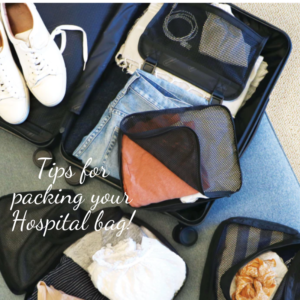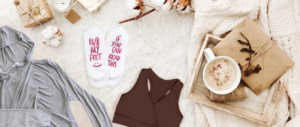
What to Pack For The Hospital
Here is a fun and practical packing tips list with the dos and don’ts of packing for your birth. Remember your birthplace is unique but these are universal guidelines to make this tradition easier for you.
Footwear
Most hospitals won’t let you walk around barefoot (and you probably won’t want to). Bring easy slip-on shoes like hard-soled slippers or flip-flops. You may also want non-skid socks to keep your toes warm.
Nursing Bra & Breast Pads
After your placenta is birthed, your body’s estrogen and progesterone levels drop and your prolactin levels increase bringing in your milk. The amount of milk you produce right after delivery varies and your breasts may begin to leak colostrum and get engorged, so a properly fitting and comfortable nursing bra is critical along with a favorite travel nursing pillow. You will also need nursing pads once you get home and possibly a sleeping bra too.
Phone & Camera
You will definitely want to contact relatives and take some photos, so don’t forget these technology essentials or their chargers. I encourage you to have prearranged your method of contacting friends and family as well as your requests about revealing personal news on social media. Most hospitals offer in-hospital newborn shoots (for an additional fee) if you are not skilled or want to leave the first impressions to the professionals.
All hospitals and birth centers now offer free Wi-Fi so remember your charger and update your music subscriptions. I would even show your partner your favorite playlists.
An Outfit to Go Home In
You will be about the same size when you go home as you were at five months into your pregnancy. Pack an easy-to-slip-on outfit that allows for the post-birth baby belly. I suggest yoga pants or a sundress.
Infant Car Seat
The hospital won’t let you leave without making sure the car seat is properly installed. Visit safercar.gov to find out more about choosing and installing the best car set for your child.
Snacks & Drinks
Expect labor and delivery to be restricted to clear fluids. This typically includes apple or cranberry juice, tea, black coffee, popsicles, and Jell-O. Postpartum, the restrictions will be removed within minutes or hours of your delivery. Consider having a small meal or a favorite snack packed and ready for your first meal.
Once in recovery ask your visitors to bring food for you when they come to visit. Also, ask the front desk about restaurants that deliver and order at the main entrance where you can pick up the food from them.
Some families choose to bring a token of thanks to the staff. Nursing favorites are hand cream, fresh fruit, meals, and occasional sweets like cookies and chocolate. Baking in early labor can be a great way to pass the time as you wait for active labor.
Sleep Aids
While the laboring partner can request sleeps aids, the noon-laboring partner cannot. So, packing Motrin, medications, and sleep aids may be critical for them.
Consider bringing your own pillows or a throw to make your recovery more comfortable. Earplugs and a sleep mask can help you catch some sleep during the day, especially when combined with your relaxation music mix, a sound machine, or ambient noise.
Delivery Gowns or Nursing Postpartum Gowns
Some hospitals require you to wear the delivery gowns they provide while others give you the option of choosing your own garment. For some people wearing the hospital, the hospital gown is synonymous with being sick, so the act of purchasing and wearing your own special labor and delivery gown can maximize your comfort and confidence. After delivery, a nursing nightgown might be a good choice. This type of sleepwear will allow easy nursing access while keeping potentially constricting waistbands from bothering your incision.
What To Leave At Home
Breast Pump & Supplies
Most moms won’t need to pump while in the hospital, and if they do there are hospital-grade pumps available for your use. Remember to take the pump accessories home with you as you may be able to use them with your unit at home and the hospital will throw them out.
If you sought out a lactation consultant before labor, pack what she tells you to for breastfeeding including a nipple shield if necessary.
Postpartum Clothes
Most postpartum women look and feel five months pregnant for a while after birth—and that’s normal! In those first few days and weeks, you may spend a lot of recovery time sitting or lying in bed, you’ll want comfortable pants with an elastic or drawstring waist. If you’re nursing, you’ll need tops with easy access. Nursing clothes don’t have to be ugly or bland, rather new moms can look and feel amazing.
Postpartum Panties
The hospital will give you an ample supply of stretchy, thin, gauze-like underwear, and I sing their praises for the first few days postpartum. Since I wasn’t moving around much, they kept my pads and ice packs in place well enough, and since they’re disposable, I never worried about ruining them. However, when you’re ready to ditch the mesh undies, you’ll want a few pairs of soft and stretchy recovery panties.
Numerous Baby Clothes
You will be spending most of your hospital time skin-to-skin with the baby and then the baby will be swaddled for sleep. Pack an outfit to take the baby home in and leave the rest at home. However, add in a couple of hats and blankets for the ride home.
Jewelry
You may feel naked without your staple jewelry, but your hands may swell during labor, making rings very uncomfortable. You will have peace of mind knowing these items are safely stored at home.
Pads & Diapers
Hospitals will provide diapers, wipes, and many of your newborn’s needs. I encourage you to leave those items for you and the baby at home.
The BOTTOM LINE
The hospital staff is more than accommodating with the essentials but know yourself and what you need to feel comfortable. Take a few minutes to prepare ahead of time. It is easier to absorb information and make plans for recovery before you are sleep-deprived and need assistance.

